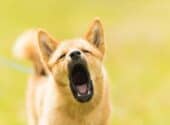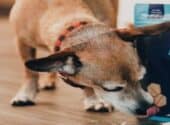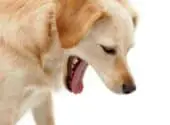Experiencing an overload of eye boogers from your furry companion? Fear not, as we are here to offer assistance! As pet owners, managing the discomfort suffered by our dogs due to eye discharge is a difficult task. Not only is it uncomfortable for them, but if not attended promptly, infections may occur.
In this article, we show you how to soften dog eye boogers using easy and effective methods.
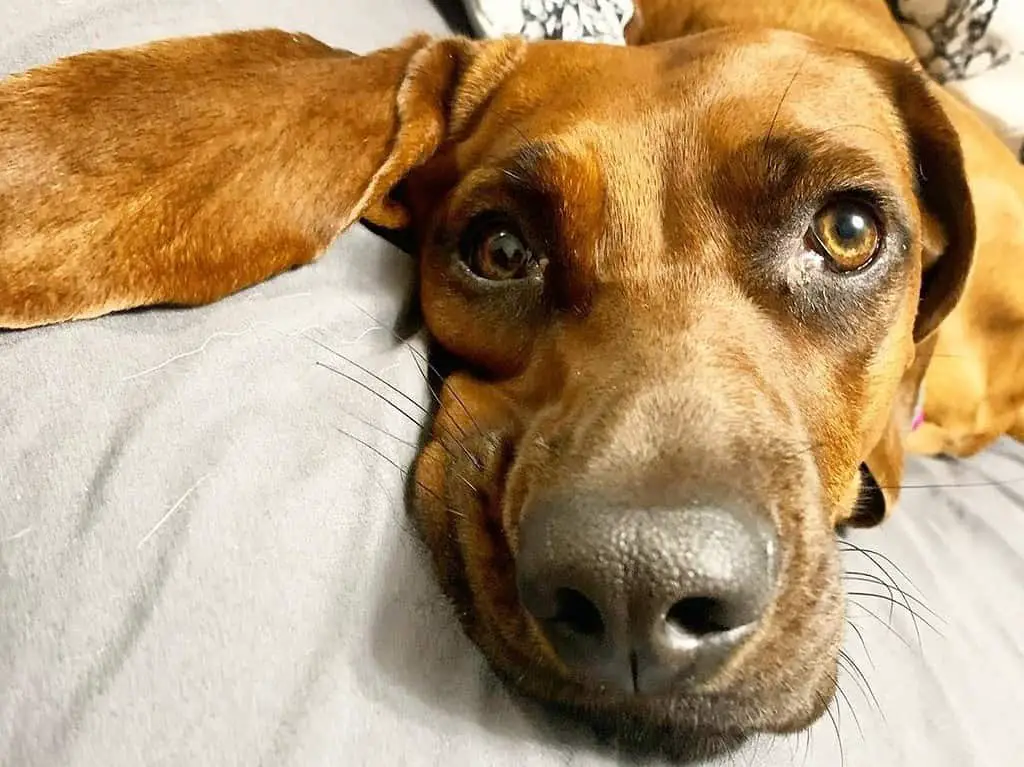
Dog Eye Boogers: What Are They?
The term “eye boogers” refers to the accumulation of substances produced within a dog’s eyes. Also called eye discharges or tear stains, these substances can range in colors, consistencies, and quantities, appearing as crusty, sticky, or runny discharges.
Dogs produce tears to lubricate and guard their eyes. The composition of these tears includes water, mucus, oils, antibodies, and other elements that serve to purify and hydrate the eyes. When tear production works as it should, excess fluid drains through the tear ducts, leaving no visible residue around the eyes.
In some cases, the production of tears or inadequate tear drainage can cause the accumulation of eye boogers. Commonly, this occurs when an irritant or foreign object is present in the eye, including dust particles, pollen, or eyelashes. Such a protective mechanism may result in clear to slightly cloudy eye boogers; fortunately, these generally disappear when the irritant is removed.
A wide range of causes could be attributed to the formation of eye boogers in dogs, such as infection, allergic reactions, anatomical defects, or an undiagnosed medical issue.
Read on as we discuss why dog eye boogers occur in the next section.
Understanding the Causes of Dog Eye Boogers
Branchephalic Face
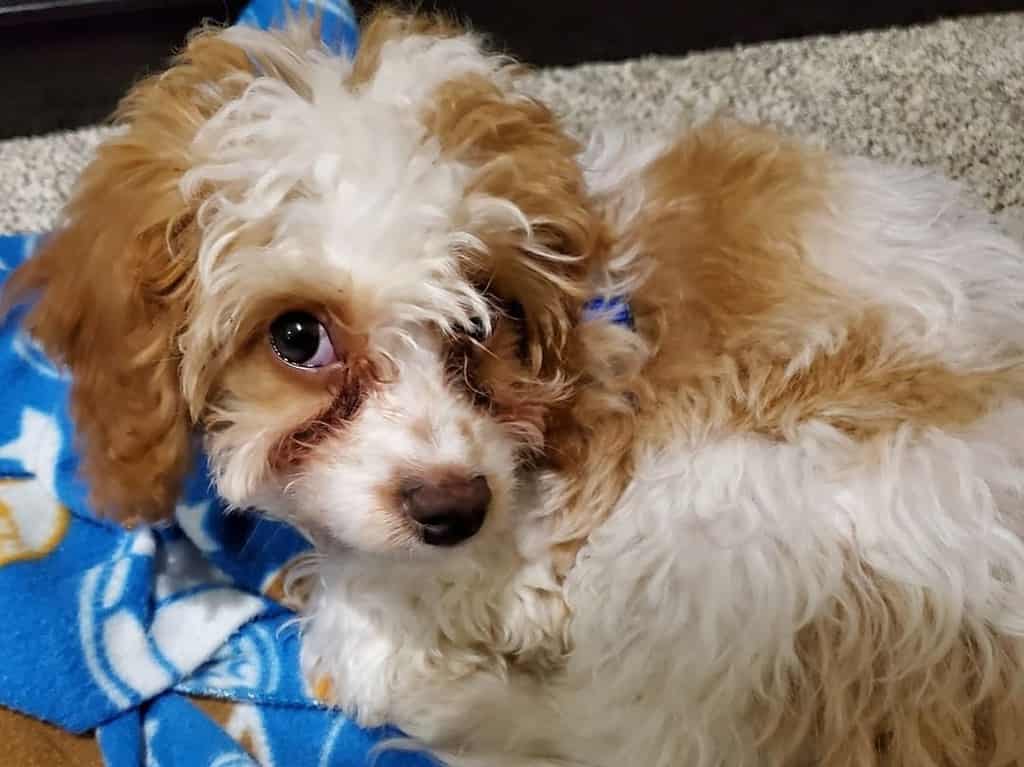
The facial structure known as brachycephaly, otherwise referred to as a ‘flat face,’ is characterized by the compression of the skull and a significantly shortened muzzle. While this trait typically gives breeds such as Bulldogs, Pugs, and Shih Tzus an endearing look, it can also result in various health concerns. Eye-related issues like the emergence of eye boogers are among those which have been reported.
Additionally, the reduced depth of the eye sockets in flat-faced dogs renders their eyes more vulnerable to external irritants or damage. Particles like dust, pollen, and even eyelashes can often become lodged in these shallow sockets, causing further irritation and increased production of tears. An accumulation of tears and bacteria may lead to infection if not adequately monitored.
Dry Eye
When a dog’s body fails to produce adequate tears, their eyes become deprived of moisture, and they endure dry eye.
Dogs with dry eye can experience uncomfortable symptoms, including itching, inflammation and soreness near the eyes. This may instigate a need to scratch or paw at their eyes or rub their face into furniture fabrics and carpets. The discharge from the eyes can also harden, causing eyelids to become closed together, making it hard for the animal to open them.
A physical examination must be conducted on the dog to properly diagnose dry eye, with significant attention given to the ocular region. The veterinarian will intently observe any signs such as redness, discharge, squinting, or rubbing of their eyes. Additionally, they should evaluate the general health of the dog and ask about any previous medical history or current medications that could result in dry eye.
The vet may additionally complete a fluorescein stain examination. This procedure involves placing a fluorescent dye on the ocular surface to assess damage inflicted by inadequate lubrication, such as dry spots or ulcers on the cornea, that are typical in dry eye cases.
As you can see, an accurate diagnosis of dry eye in dogs is obtained by taking into consideration the results from multiple evaluations, including clinical signs, physical examination findings and diagnostic tests. The veterinarian will combine this data to arrive at a conclusive diagnosis. Upon confirmation of dry eye, the medical team will collaborate with the dog’s owner to generate a comprehensive treatment that will facilitate management of the condition.
Conjunctivitis
Inflammation of the conjunctiva, the thin membrane that covers the front surface of the eye and lines the inner eyelids, is called conjunctivitis or commonly referred to as ‘pink eye’.
Conjunctivitis in dogs frequently manifests itself as an increase in the mucous production of the conjunctiva, which eventually leads to the formation of discharge. The quality and quantity of this discharge varies based on the cause behind the conjunctivitis, displaying various consistencies, colors, and amounts.
Conjunctivitis in dogs is often a result of allergies, which can be provoked by allergens such as pollen or dust mites, various foods, and other environmental irritants. This stimulation of an allergic response leads to inflammation and the production of clear or partly cloudy eye discharge.
It can also be caused by Conjunctivitis in dogs can be caused by either bacteria or viruses. If the cause is bacterial, generally a thick yellow or green pus-like discharge will occur; however, if it is viral, initially the eye secretions may appear clear and watery but progress to become more dense. In such circumstances, it is likely for clumps of mucus to form in the eyes and be quite visible.
After determining the underlying cause of the condition, your veterinarian may prescribe certain medications to treat it. Bacterial conjunctivitis typically requires antibiotic treatments applied as ointments or drops, while viral conditions require antiviral medications. With regards to reducing inflammation and providing relief from discomfort, prescribed options include both steroidal and non-steroidal anti-inflammatory eye drops.
Allergies
Allergy-induced eye boogers in dogs are a frequent phenomenon. These substances, be they gooey or crusty, often appear in conjunction with other signs, such as redness and swelling of the eyes, excessive blinking or rubbing of the eyes, squinting, itching around the eye area. Additionally, canines enduring allergic reactions may experience sneezing and coughing episodes besides itching on different parts of their bodies and skin rashes.
It is vital to detect and eliminate or minimize contact with the specific allergens that cause allergic reactions when attempting to control symptoms of eye boogers. This may include cleaning the environment in which the dog lives, using an air purifier, frequently changing bedding and evading exposure to known allergens.
How To Soften Dog Eye Boogers
Use a warm, soft towel or a cotton ball.
A warm, damp towel can be an effective method for helping clean your dog’s eyes. Be sure to use lukewarm water as hot temperatures may cause harm or discomfort to the delicate eye area. Gently wring out any excess liquid and carefully wipe around the eyes, avoiding using excessive pressure while doing so. The warmth of the towel will help soften boogers, creating a less stressful experience for your pet in comparison with harsher removal methods.
An alternative approach to addressing eye boogers in dogs is to use a moistened cotton ball. Ensure that the water used is at a warm temperature, and delicately dab the cotton ball around the affected area for more control of targeting specific sections. It is imperative to be aware of any pressure applied in this process; it must remain gentle and no forceful movements should be made that may cause harm or discomfort to your dog’s eyes.
Use dog-wet wipes.
A potential means of managing the amount and severity of eye boogers in dogs is the application of a damp cotton ball. Make sure that the water used for this process is only lukewarm, as anything colder or hotter may cause discomfort to your pet’s eyes. When dabbing at the affected region with said cotton ball, caution should be exercised towards any pressure you may be applying; excessive force should not be used to avoid causing injury or unease for your pup.
Begin by firmly grasping your dog’s head and using a sterile wipe to carefully remove any excess discharge near the eyes. Ensure that you do not come into direct contact with the eyeball since this can lead to discomfort or harm. Utilize a new wipe for each eye so as to reduce the risk of potential infections being spread.
Consider dog eye drops.
How to soften dog eye boogers?
Dog eye drops can be used to soften the eye boogers, making them simpler to remove and thus promoting better eye health for our canine friends. Typically, such drops contain light saline solutions or lubricants that help to hydrate the eyes while relieving symptoms of dryness and allowing removal of crusty boogers.
When selecting an eye drop solution for your dog, it is important to choose a product designed specifically for use in canines. As human eye drops may contain ingredients that could be dangerous or detrimental to the wellbeing of your pet, opting for ophthalmic solutions tailored toward a dogs needs and sensitivities is essential. Dog-specific eyewashes are proven safe and gentle on doggie eyes, so ensure you make this selection carefully.
Use a dog eye stain remover.
Many breeds, especially those with light-colored fur, often experience the accumulation of tears on their faces, which can leave behind unsightly stains of brown or red.
Dog eye stain removers are formulated with soft components that facilitate the breakdown of crusty discharge for effective removal without damaging the delicate eye area. This can be advantageous for dogs that produce excessive tears or have physical characteristics which encourage staining.
These products for treating eye stains can come in varying forms, including wipes, cleansers and gels. They are typically applied directly around the eyes without necessitating rinsing; thereby providing an expeditious and straightforward method of application. Furthermore, some dog eye stain removers feature applicator tips or pads to ensure accurate administration of product to areas that require attention.
Use a dog eye comb.
The dog eye comb is designed with rounded and subdued teeth so as to make it protective and relaxing to use on a pup’s fragile eye area. Typically, the teeth of the comb are produced from a pliable, suppleness material such as silicone or rubber in order to avert harm or abrasions being inflicted upon the dog’s eyes while effectively lingering over and softening any occurs of eye boogers.
It is essential to exercise caution and diligence when utilizing a dog eye comb. Initially, moisten a clean cloth or cotton ball with warm water or an optometrist-recommended eye cleaning solution. Utilize the cloth to delicately eliminate any superficial or surface discharge that has gathered near the dog’s eyes.
Subsequently, grip the dog eye comb tightly yet delicately, and systematically brush away any hardened discharge around the eyes. Utilize as little pressure as possible to avoid hurting or wounding the dog. With its smooth teeth, the comb can help loosen and soften the boogers for easier removal.
Incorporating the utilization of a dog eye comb into normal grooming habits can assist in upholding proper eye hygiene and deflect any future discomforts or afflictions related to the eyes in dogs.
If all else fails, ask your vet for some advice.
Contact a veterinarian for a proper evaluation and medical advice if your dog’s eye boogers continue or any changes in their eye health arise. Symptoms such as serious tearing, redness, swelling, squinting or vision alterations may indicate an underlying problem that requires immediate veterinary care. Taking prompt action can halt the growth of eye boogers and maintain your dog’s overall eye health.
Bonus Tips: Do not clean your dog’s eye booger using your fingers.
Removing eye boogers with your fingers can have detrimental consequences. The presence of bacteria, dirt, and oils on our hands may be transferred to a dog’s eyes, leading to infection or irritation. Moreover, the delicate nature of this organ makes them vulnerable to rough treatment and even potential corneal damage if handled incorrectly. It is important that appropriate hygienic measures are taken when caring for your pet’s eye health.
Dog eye boogers can also be challenging to remove due to their tendency to either stick or adhere themselves in the fur. Not only will this method bear little results, but it also has potential of increasing the issue if discharge is smeared further into or even pushed into the eye.
Moreover, using inappropriate tools or techniques may also cause unnecessary discomfort for your dog, leading to resistance or fear of eye cleaning in the future.
In many cases, continual eye discharge in dogs can be an indication of a more serious medical issue that may need to treated. Allergies, infection, or even conjunctivitis or dry eye syndrome can all be potential causes of dog eye boogers. Although removing the secretion from the eyes may provide temporary relief, this does not address the core problem and will not effectively resolve it. Thus, it is essential to seek advice and treatment from a qualified veterinary professional in order to accurately diagnose and manage any ongoing issues with your dog’s eyes.
Do not use nail clippers to snip away the crusty booger.
Utilizing nail clippers, generally used for grooming a dog’s nails, poses substantial threats when they are employed near the delicate eye area. Such trimmers were not fashioned to be utilized on strictly sensitive areas such as the eyes which could result in severe injury to a dog’s sight if done so. The eyes are very fragile organs whose handling and use of tools must be done carefully to protect from damage or pain caused by misuse. Additionally, there is also potential for yourself to sustain an cut while attempting this endeavor.
How To Prevent Dog Eye Boogers
Prevention of the formation of eye boogers is one effective way to manage their presence. While it may be impractical to entirely eradicate these discharges, a reduction in their frequency and extent can certainly be achieved with consistent effort.
Consistently practicing good hygiene habits can prevent eye discharge in dogs. Use a soft material, such as cloth or pet-friendly wipes to carefully remove any buildup around the eyes. Make sure not to put too much pressure when cleaning the area and refrain from using any harsh chemicals that could harm your pup’s eyes. Practicing regular cleanliness procedures can decrease potential settlements of debris and consequently diminish the opportunity of eye boogers forming.
Having regularly scheduled veterinary check-ups is essential to identifying and addressing potential health problems that can cause unsightly eye discharge. During an evaluation, your veterinarian will carefully examine the eyes and determine if further action must be taken for treatment or prevention. If your canine friend has a susceptibility to dryness or irritation, eye drops or ointments may be prescribed as part of their care plan to both soothe and hydrates the eyes.
Environmental elements may also be responsible for causing eye boogers in dogs. Allergies triggered by dust, pollen, smoke and other irritants may lead to extreme tearing as well as deposition. Reduce your dog’s exposure to such irritants by avoiding environments that are heavily-contaminated with smoke, areas with high levels of dust and providing adequate ventilation in their living space.
Lastly, maintaining your dog’s facial hair by trimming it can help reduce the likelihood of eye irritation and the buildup of dirt which could result in an eye discharge.
Frequently Asked Questions
Can I use coconut oil to soften dog eye boogers?
The general consensus is that coconut oil should not be used to soften canine eye discharge without speaking to a veterinarian first, despite the various uses and benefits that coconut oil may provide.
How can I differentiate between normal eye discharge and abnormal eye boogers in my dog?
When the quantity of eye discharge increases, it indicates abnormality. Tearing besides average tear production should also be monitored and noted. Cleaning eyes more than occasionally may signal a particular health issue that requires medical attention.
Can a change in my dog’s diet or nutrition help reduce the occurrence of eye boogers in dogs?
Altering a dog’s diet or nutritional intake may not result in the direct removal of eye boogers, but it could improve overall eye health, which might indirectly impact their presence.
A handful of nutrients have been directly correlated to improved eye function, such as omega-3 fatty acids, antioxidants, and vitamins A, C, and E. Making sure these nutrients are present within your pet’s diet, either through premium pet foods or supplements is one of the best ways to guarantee optimal eye function.


